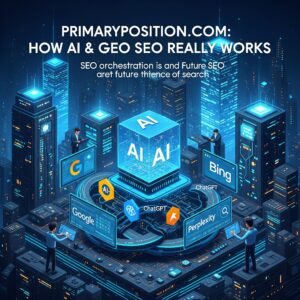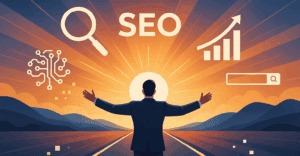Table of Contents
ToggleA Primer on GSC And GA4 Data
I’m seeing this question more and more, and as Google Analytics (aka GA4) becomes more of data wasteland thanks to GDPR, this question will grow more and more. So – which one to trust? GSC and Analytics used to be within 90% of each other and this question was still asked, but its increasingly common that GSC and GA4 could be as much as 80% off now. GSC doesn’t differentiate between users or sessions – it just tracks impressions and clicks. These clicks could include some from the same user or just be unique. The bottom line isn’t just that GSC and Analytics data don’t correlate – its that marketing attribution is now dead.
This is all going to change and it should be terrifying to marketers, SEOs, PPC managers, and CMOs alike
What data is in GSC?
Google Search Console (or GSC) lists all of the data from Google organic search. It only includes searches within Google Organic. In Analytics, Organic search will include most of the search engines, including Bing, DuckDuckGo, and others search engines. This was the main difference. But basically, from now on – Google Search Data will be the most trustworthy and the “Book of Truth” for all things Google SEO/Organic traffic and its composition.
Is Google search console GDPR compliant?
Yes, GSC doesn’t use cookies and anonymizes data to make it GDPR Compliant.
How is GSC different from GA4?
Well, before consent mode 2, GSC and Analytics tracks users differently and there are four viewpoints for understanding a user journey:
- Users
- Sessions
- Visits
- Clicks
It’s worth noting that Google Ads tracks users the same way. Both, at least as far as we know rely predominantly on Cookies – with Google Ads caring the least. As GA4 users are being further forced into adopting Consent Mode v2 from the EU’s broken and draconian GDPR law, this data blackhole is about to get a lot worse.
What is the difference between GA4 sessions and GSC clicks
Google Search console doesnt differentiate between sessions or users. A session in GA4 is a collection of pages. actions and/or events by a single user. A user in GSC may be one or more clicks. Only GA4 (with consent mode v2 denied) can tell. Without the data degradation of consent mode V2 – GSC should log more clicks than GA will log users.
Does Google Search Console use cookies
No, GSC doesnt use cookies per se but users are normally tracked within the Google system and with PPC cookies unless disabled.
Impact of Consent Mode v2
Since Consent Mode v2 however, may mean that GSC logs 100% or 2X the number of clicks to GA4 Sessions logged.
Sitemaps in GSC
GSC lets you upload XML Sitemaps which help you control what % of your site is indexed or not. XML Sitemaps do not control Google or ensure anything gets published – so read our blog post on XML Sitemaps and SEO.
Clicks and sessions and users: What’s the difference?
A user is the person who does the clicks. The same user could do a search in Google and be:
- Google Ad Impression
- Google My Business Impression
- A Google Organic impression
Depending on which result the Google user clicks, then defines the channel they are in. For example, by clicking on an Ad, Ads will track them as a Paid user. If they consent to cookies, so will Analytics and also marketing software like Hubspot or Salesforce.
So if a user does 10 searches over a week, and 3 of them are on ads, in Analytics they will show as 1 user, with at least 2 sessions and 2 visits. The first visit will be new and the second will count as a return visit.
In GSC, they will just show as 7 clicks and in ads as just 3.
Mobile Apps Further Degrade Channel Attribution
Traffic Channels for Analytics have almost always relied on what’s called “HTTP Header Referral” data – where the browser passes on visitor information from one site to another per W3C standards from the 1990s.
UTM and Google Analytics
Since Google’s acquisition of Urchin, which gives us Analytics – this is partially augmented by UTM information. Other tools, like the CMS itself in the case of Hubspot for example, also honor or interpret UTM data.
However, Apps don’t run inside browsers, so more and more data is captured as “Direct Traffic.” A lot of people think Direct means the user entered the web address directly into the address bar but this is less and less likely.
We estimate that right now as much as 40% of Direct traffic is search and social. Apps like Google App, Edge, Google Chrome, Linkedin, twitter/X, and Facebook apps don’t provide referral information
GDPR is encroaching on US sites too
While this was initially an “EU” issue, because EU law is so wide (defined as any EU citizen), more and more US companies, especially global ones with subsidiaries or parents in Europe, and Google just enforcing a global lockdown, nobody is safe!
Is there Google Ads Data in GSC
Technically there’s no Google Ads data in GSC but … if you rank organically first or at least on page one for the same country – the impression data may likely overlap, The problem is that GSC isn’t great at slicing GEOs and there may be reasons why you don’t rank, e.g. for personalization – so there’ll
Further Degradation of Data
The data degradation and subsequently attribution, is now starting to get worse, however. Many organic (and also users from apps like Google and Edge) visitors are not even showing in GA4 because they aren’t consenting to cookies. Read more about what data Google Analytics can’t track.
This is going to kill digital channel attribution
Example of Google Analytics Channel Attribution
Let’s say our user is currently searching for the best “SEO Expert” and performs a number of searches in Google and also clicks on a few tweets from some well-known SEO experts on twitter. Analytics is able to track this user via cookies, from all channels. After the user has researched and found an enterprise SEO Agency they like, they may sign up via a last-touch search or click from say a LinkedIn profile. Google Analytics and Ads have a number of different attribution models that reward each participant in this customer journey – from the First click to the last click. Putting more weight on the last channel is known as Last Click Attribution and visa versa for First Click Attribution. Many models use equally weighted where each step gets the same % reward.
This is all going to change and it should be terrifying to marketers, SEOs, PPC managers, and CMOs alike because, without Cookies, Analytics cannot tie these visits together, which means Google Ads is going to get more and more of attribution because it will keep tracking users – eating revenue from places like Paid Social, Organic Search and Organic Social Traffic








